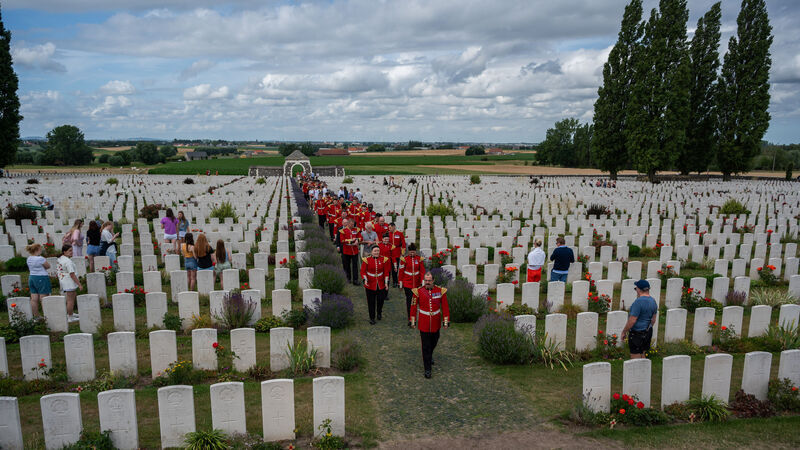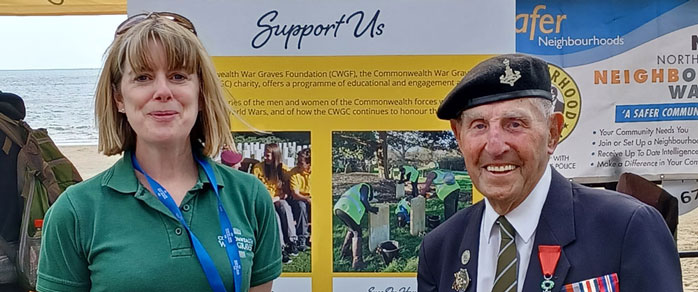03 March 2025
Women at War: The Courageous women who served and fell in the World Wars
Women played a significant role in both World Wars. Here we salute the sacrifice and share some of the stories of servicewomen commemorated by Commonwealth War Graves.
Women at War
Women in the Great War

Image: Two members of the Women's Army Auxiliary Corps tend to war graves in Abbeville Military Cemetery, France, in February 1918 ( © IWM (Q 8470))
Women of all ages and nationalities served in the great struggles of the First and Second World Wars. At Commonwealth War Graves, we commemorate over 3,600 servicewomen of the World Wars of Commonwealth forces.
 Image: A WAAC recruitment poster encouraging women to join the war effort (© IWM (Art.IWM PST 13194))
Image: A WAAC recruitment poster encouraging women to join the war effort (© IWM (Art.IWM PST 13194))
During the Great War, over 120,000 women served in nursing-related roles in organisations such as Queen Alexandra’s Imperial Military Nursing Service (QAIMNS) and the Territorial Nursing Service (TFNS).
Many others went to the frontlines and set up hospitals on their own initiative. Scottish doctor Elsie Inglis was one such woman. In 1914, she offered her help but the War Office turned her down with the words “My good lady, go home and sit still.”
Elsie did the opposite. She instead set up Scottish Women’s Hospitals for Foreign Service, creating 14 units that operated in France, Malta, Salonika, Serbia, Romania, and Russia.
Elsie sadly did not survive the war. She contracted bowel cancer and died one day after returning from her work in Serbia on 26 November 1917. As this illness was not the result of her wartime service, she is not commemorated by Commonwealth War Graves.
But women did not just serve in medical capacities. The Women’s Army Auxiliary Corps (WAAC), renamed Queen Mary's Army Auxiliary Corps in April 1918, was founded in December 1916. Its members performed important duties to support the men at the front.
WAAC members were drivers, mechanics, cooks, clerks, waitresses, seamstresses, and held many more roles all designed to keep the Army ticking.
Off the back of the WAAC’s formation, the Women’s Royal Naval Service and Women’s Royal Air Force were set up. In total, around 100,000 women served in the armed forces during the First World War.
Away from the armed forces, women plugged the gaps left by men. Munitions factories, for example, relied heavily on female workers to feed the war machine with weapons and ammunition. The first British female police officers were hired during the First World War too.
Second World War service

Image: A Wren of the WRNS performs semaphore (© Image IWM (A 1712))
As with the men, a new generation of women were called upon to serve when the Second World War broke out in 1939.
From early 1941, all women aged 18 – 60 had to register for war work and from December 1941, women were conscripted into roles such as mechanics, munitions work, air raid wardens, bus drivers, farming or the armed forces.
At first, only single women between the ages of 20-30 were called up and given a choice between joining the armed forces or working in industry. This later changed to include women aged 19 - 43 as the need for the civilian population to help the war effort increased.
By 1944 around 7 million women were engaged in war work.
Those who elected to join the armed forces had the option to join one of the three major female services:
- Auxiliary Territorial Service (ATS)
- Women’s Auxiliary Airforce (WAAF)
- Women’s Royal Naval Service (WRNS)
Initially formed in 1938, the ATS initially only offered women jobs like cooks, clerks, orderlies, store women or drivers.
By the war’s end, however, the service had greatly expanded and more than 100 different roles were available to female ATS recruits, including service in anti-aircraft batteries.
The ATS was the largest of the three women’s services with over 250,000 members by the end of the Second World War. Perhaps its most famous member was the young Queen Elizabeth II, then Princess Elizabeth,
The Women’s Auxiliary Air Force was founded in June 1939. While this freed up more men for frontline duties, it also greatly expanded the opportunities for women during wartime. By 1943, it had 182,000 members.
WAAF’s roles were many and varied. Their duties included radar operation, weather reporting, aircraft maintenance, intelligence gathering, and serving on airfields. They were supported by the Air Transport Auxiliary where women pilots helped ferry aircraft to and from factories and workshops to frontline units and depots.
Women also served as aerial photograph interpreters for the aerial reconnaissance section of the RAF, including Prime Minister Winston Churchill’s daughter Sarah.
Women plotters and radar operators served with great distinction during the Battle of Britain, for example, helping the Royal Air Force win one of its earliest, greatest victories of the war.
Some 74,000 women served in the Women’s Royal Naval Service. Known as Wrens, after WRNS, they served in shore-based jobs at home and overseas.
They were integral to naval planning. For instance, from 1941, Wrens were part of the codebreaking teams at Bletchley Park, operating the early computers used to crack enemy codes like the elusive enigma.
Other organisations women volunteered for during the Second World War include the First Aid Nursing Yeomanry (FANY), Women’s Voluntary Service (WVS), and the National Fire Service.
Women served in similar organisations across the Dominions too. Female service was not just restricted to the UK.
They were not allowed to carry or fire weapons, but the work they were doing was often dangerous, and of course, many of these women, just like male casualties in Commonwealth War Graves' care, died during their service of war related injuries, in air raids, or in accidents or of illness.
Spying and espionage
 Image: Violette Szabo, one of the most famous SOE operatives of the Second World War (Wikimedia Commons)
Image: Violette Szabo, one of the most famous SOE operatives of the Second World War (Wikimedia Commons)
Some of the most dangerous roles tackled by women in wartime were those undertaken by the female field operatives of the Special Operations Executive (SOE).
SOE was established in July 1940 at the instigation of Winston Churchill. Designed to “set Europe ablaze”, SOE conducted espionage, sabotage, and reconnaissance across German-occupied Europe, as well as aiding local resistance movements.
Around 13,000 people were employed or controlled by SOE, 3,200 of which were women. However, only a tiny number, just 39, of female operatives were sent into the field.
Demonstrating the risks they faced, 15 of those lost their lives: one to disease, the others arrested and executed in concentration camps.

Want more stories like this delivered directly to your inbox? Sign up for our newsletter for regular updates on the work of Commonwealth War Graves, blogs, event news, and more.
Sign UpWomen at war: Telling their stories
Sister Elaine Lenore Balfour-Ogilvy
 Image: Sister Elaine Lenore Balfour-Ogilvy (Australian Virtual War Memorial)
Image: Sister Elaine Lenore Balfour-Ogilvy (Australian Virtual War Memorial)
One of the most shocking losses of women during the Second World War took place on 12 February 1942 on the Indonesian island of Bangka. Sister Elaine Balfour-Ogilvy was one of 22 nurses executed by the Imperial Japanese Army that day.
Elaine was born in 1912 in Renmark, South Australia. After education, she went into nursing and, when the Second World War broke out, she decided to join the war effort, putting her skills to use in the Australian Army Nursing Service.
Enlisting in 1940, Elaine left Australia’s safety for Malaya (present-day Malaysia), arriving in March 1941. There, she settled into life as an army nurse on active overseas service.
Elaine’s world changed dramatically nine months later. The forces of Imperial Japan had begun striking across the Pacific. The attacks on Pearl Harbour in December 1941 heralded a new age of Japanese conquest. Soon, Imperial Japan was making headway through Malaya, heading for British-held Singapore.
As Japanese forces closed in, the number of wounded Elaine and her fellow nurses cared for rapidly increased. On 12 February 1942, patients and nurses were evacuated to what they hoped was safety aboard the SS Vyner Brooke, narrowly escaping the Fall of Singapore.
Two days later, while at sea, the Vyner Brooke was bombed by Japanese aircraft. Wounded soldiers, medical staff, as well as civilians and children, were all plunged into the sea.
Some made it to lifeboats and dinghies and were able to make it to Bangka Island, off the coast of Sumatra. With them were Elaine and 21 fellow Australian nurses.
While they cared for casualties, the civilians headed inland to surrender to the approaching Japanese forces. Later that morning soldiers arrived.
They forced the wounded who could still stand to walk around the headland. The nurses heard shots echo along the beach and the Japanese returned with bloodied bayonets. Then they set up a machine gun, herded the nurses into the sea and shot them. Elaine was 30 years old.
Against all odds, one nurse survived and would eventually testify to the war crime on Bangka Island.
Until then, Elaine’s family had no idea what had happened to their daughter – their sister – but that she was missing with the Vyner Brooke.
Elaine and her fellow nurses killed on Bangka Island are commemorated by name on the CWGC’s Singapore Memorial.
YMCA Volunteer Bertha “Betty” Stevenson
 Image: Better Stevenson (Pubic domain)
Image: Better Stevenson (Pubic domain)
Betty Stevenson was born in York on 3 September 1896.
She lived in Harrogate where she was educated at home, before attending St George's Wood Boarding School, Haslemere, Surrey. Betty's parents were activists of the YMCA and she became heavily involved, at a very young age.
At the age of 16, she travelled with her parents to London as part of a group from the local Belgium Refugee Fund, to bring back to Harrogate refugee families who had been camping out at Alexander Palace.
Betty worked on the project with a man named Henry Brice, who she was to stay in touch with throughout her work for the YMCA.
Brice later said of her: "If I had ever an impossible task to do, I would have put Betty to do it. And what's more, by her personality she would have got people to help her, and if she failed a hundred times, you would have found her head erect and smiling... her judgement was always sound, and her happy confidence in herself irresistible."
In January 1916, one of Betty's aunts went to France to manage a YMCA Canteen in St Denis Hut, on the outskirts of Paris.
Betty was keen to join her. At 19, she was considered too young but a month later she went anyway, paying her own expenses. She enjoyed the work, writing: "We know how grateful the men are, and they know us now so well, I somehow feel it would be mean to leave them for a new place."
Once her term at St Denis was completed, Betty returned to the UK but she was soon anxious to get back to France.
In April 1917, she was posted to Etaples as a YMCA driver, responsible for transporting lecturers, concert parties and relatives from England visiting the wounded in hospital.
Betty described Etaples is a letter to her father: "I'm awfully fond of the river here. There is a bridge over it from which you can get the most wonderful view of everything. On one side the river mouth and the sea and the little fishing boats; the quay and the big sailor's crucifix, where the women pray when there is a storm at sea.
"The boats anchor quite near; and they look like something hazy and unreal, sitting on a shiny wet river; with every sail and mast and man reflected in the water. Behind them are houses - filthy and ramshackle, but with the sun warming their pink, white and grey roofs.
"Behind the houses again is the camp - the tents crawling up the hill like white snails, and more hills and pines behind them. The whole thing is so illogical, boats and fisherman on the one hand, and on the other, war."
Betty was killed by an air raid the following year having, despite the danger, stayed in the area to assist some French refugees.
She was given a military funeral and was posthumously awarded the Croix de Guerre avec Palme by General Petain, for courage and devotion to duty.
The personal inscription on her headstone reads simply, "The Happy Warrior".
Section Officer Yolande Elsa Maria Beekman
 Image: Yolande Beekman (Wikimedia Commons)
Image: Yolande Beekman (Wikimedia Commons)
Yolande Beekman was born Yolande Elsa Maria Unternährer to a Swiss father and English mother in Paris, France on 7 January 1911.
Yolande had a soft, gentle personality and loved to paint and draw. After her education, her parents thought she might become an illustrator or artist. Her adult life turned out to be much different.
Due to her upbringing, Yolande was fluent in German, English, and French. Her language skills would attract the attention of SOE recruiters in wartime.
When the Second World War broke out, Yolande volunteered for the WAAF as a W/T operator, trained to use a radio to send and receive messages.
While on her training course, she met and married Dutchman Sergeant Jaap Beekman of the Netherlands Army.
A highly competent radio operator, and fluent in multiple languages, Yolande was recruited by SOE in 1943.
She was dropped into France on 17/18 September 1943 to act as wireless operator for the Musician intelligence network run by Canadian Gustave Biéler in Saint-Quentin, northern France. Yolande also transmitted messages for Michael Trotobas’ adjacent Farmer network.
Initially working out of multiple safehouses, as per SOE policy, gradually Yolande began to operate solely out of the attic of a house owned by resistance member Odette Gobeaux. This was incredibly risky.
SOE agents were encouraged to move around so as to avoid detection by Gestapo direction finding (D/F) teams. D/F teams used sophisticated equipment to track and monitor radio signals. If caught, an SOE wireless operator could expect imprisonment, interrogation, and execution.
This was sadly the fate of Yolande Beekman.
Her regular schedule of three messages a week on regular frequencies, coupled with staying static in one location, made her an easy target for D/F teams.
On Christmas Day 1943, she contacted London as usual. A week later, a detection finding van passed the house: a bad omen for what was to come.
On 12 January, Yolande’s close companion and Musician circuit member Camille Boury reported seeing a man in a high-collared coat on the street outside the safehouse wearing earphones. Their transmitting signal had been detected.
Yolande quickly packed up her radio and moved to the Café Moulin Brulé in the north of Saint-Quentin, but too late. On January 14, she and Musician leader Gustave Biéler were arrested by Gestapo agents at gunpoint in the café.
Yolande was first taken to Fresnes Prison on the outskirts of Paris. She was brutally interrogated and held for months before being transferred to Karlsruhe Prison in Germany in September 1944. With her were three other female SOE operatives: Madeleine Dmerment, Noor Inayat Khan, and Eliane Plewman.
They were then transported to the infamous Dachau Concentration Camp.
There, at dawn on the morning of 13 September 1944, the four women were led into a camp courtyard. Each was then executed with a shot to the back of the head by a small calibre pistol.
According to Gestapo agent Christian Ott in a post-war investigation, Yolande “still showed signs of life” before being killed with a second, final shot.
With no known war grave, and as a member of the WAAF seconded to SOE, Yolande Beekman is commemorated on the Runnymede Memorial, Surrey, England.
Women in the Second World War: A New Education Resource launched for Women’s History Month

In honour of the memory of the over 3,600 servicewomen we commemorate and as part of Women’s History Month, we have created a new resource for schools and young people that shares the stories of some of these women who served during the Second World War.
We hope that as we approach the 80th anniversary of both VE day and VJ Day, these stories will inspire young people to learn about these women and their roles in helping secure victory.
These stories are set within the wider context of women’s war work, and some of the different auxiliary and military nursing services open to women during this period. They are also cross-referenced to key events to illustrate how, for example, women from the Women’s Royal Naval Service were involved in the behind-the-scenes planning for D-Day.
Whilst primarily aimed at KS2/KS3 students, the information could be used with any age group interested in exploring the stories behind women’s roles in the Second World War.
This resource forms part of our wider commitment to education and further education and learning resources can be found on our Education Resources page.
Our Public Engagement team work closely with schools to support teachers in their activities around both world wars. Please contact public.engagement@cwgc.org if you are interested in a free visit from one of our team.
Help Commonwealth War Graves keep their stories alive
The tragedy of the World Wars saw millions of young service personnel cut down in their prime, or in the case of those in this blog, in their teenage years.
At Commonwealth War Graves, we commemorate over 1.7 million men and women who gave their lives in these world-shaping conflicts. Each one was a real person with a real story.
The Commonwealth War Graves Foundation, the charity wing of the Commonwealth War Graves Commission, was set up to help share the stories of those in our care.
Visit the Foundation website to learn more about its projects and how you can help us keep the memories and stories of those in our care alive.

The Commonwealth War Graves Foundation is our charitable arm. Discover more about their exciting projects, important mission, and how you can support the CWGF today.
Visit the Foundation
